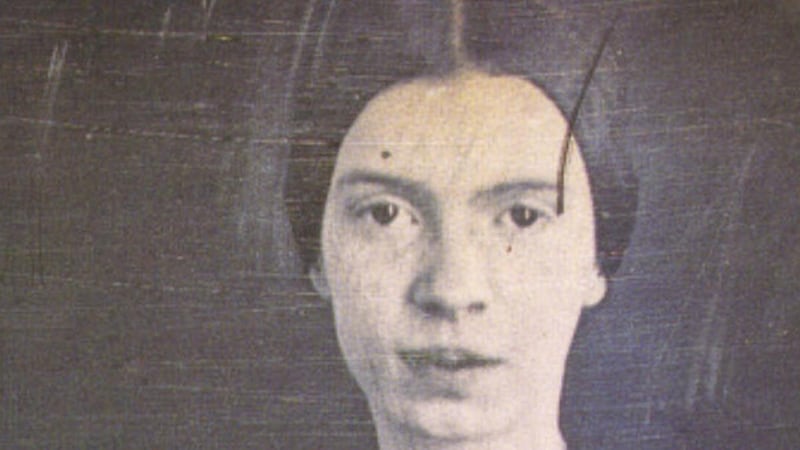The naturalist Charles Darwin and the poet Emily Dickinson would seem to be unlikely bedfellows – imagine the fascinating product that might have resulted from that concumbence – but in her fascinating and timely book Renée Bergland draws them into a web of connections. These are not direct connections; there was between the two a 21-year age difference, and the Atlantic Ocean. They never met, though they had acquaintances in common, and while it is unlikely that the literary-minded but unpoetical Darwin ever read Dickinson’s work, she had a deep and consequential knowledge of his.
Something they had in common was a visceral sense of the world as a living entity. Darwin the scientist was as keenly aware of the magical aspects of life as was Dickinson the poet, although he was more circumspect in expressing such views. Both regarded the world, writes Bergland, “with a startling combination of ecstasy and humility”; for both, there were no individual objects, only one vast community. “When viewed from a magical perspective, the world appears to be alive with relationships.”
The emphasis in that sentence is on the word “alive”. When Bergland speaks of magic she is not thinking of the spirit world but of the animal sphere, in which human beings have their lives along with the other fauna. At times, indeed, she seems to wish to include the flora as well in the sentient continuum. All things appear, flourish and die, whatever Peter Thiel and his like might contend.
But it is not a blind blundering from cradle to grave. Bergland cites the contemporary physicist Karen Barad’s argument that “matter has agency”. According to Bergland, Darwin was thinking along similar lines in the middle of the 19th century: “Darwin’s decades of carefully documented experiments convinced him that plants and animals were kin to each other and that consciousness had evolved from the very roots of the tree of life.” The language here makes one think of the recently posited internet of tiny strands of underground fungi that connect trees to each other in a gigantic communications system. Some scientists have expressed doubts about the “wood-wide web”, but there is an impressive body of evidence to support it.
READ MORE
One of the surprises of Bergland’s book is the revelation of just how much of a “naturalist” Dickinson was. She had a deep interest in and knowledge of many branches of natural science, and paid every bit as much close attention to the natural world as did Darwin himself. Yet hers was a naturalism shot through with a sense of the magical possibilities of life, and an awareness of the danger that pure science – if there is such a thing – would denature nature, and bring to the study of the world a cold, beady-eyed, lifeless detachment. Darwin entertained the same fears. Bergland writes:
“Both felt the loss of Romantic ways of thinking and mourned the growing separation of science from poetry. They worried about the disenchantment of the natural world that seemed to go along with modern thought, even as they both saw themselves as champions of unflinching truthfulness.”
Some readers may feel a certain impatience with Bergland’s repeated use of the word “magic” without offering a full definition of it. In this connection, and in connection with Dickinson’s application of the term “Magician” for certain poets – Elizabeth Barrett Browning is a strong instance – she quotes the archaeologist Chris Gosden’s contention that “the forces defined by science find echoes in magic’s insistence that spirits animate the world”. Here again, however, it is a question as to what constitutes “spirit”.
At the heart of Bergland’s book is the confrontation at a meeting of the British Association for the Advancement of Science in Cambridge in 1883 – while Darwin was aboard the Beagle on the other side of the world – between the arch-theorist of English Romanticism, Samuel Taylor Coleridge, and the polymath William Whewell. The Romantics detested, and feared, the work of the naturalists, seeing it as a deadening approach to nature and a forgetting of the marvellous. As Wordsworth had it, “We murder to dissect.” Coleridge disdained those people who, in Bergland’s words, “got their hands dirty digging for fossils, murdering beetles, or dissecting songbirds”, and insisted that they could not be considered natural philosophers.

Whewell had the solution, as least as far as nomenclature went. In the case of naturalists, he said, perhaps “philosopher” was “too wide and lofty a term”; instead, “by analogy with artist, we may form scientist”. It was the first time the word was used, and it quickly caught on. It was a handy replacement for the cumbersome “man of science”, and, not incidentally, it could include women, such as Mary Somerville, whose book On the Connexion of the Physical Sciences of 1834 was a huge success at the time.
It is doubtful if Coleridge saw Whewell’s neat piece of neologistic legerdemain as a victory, for it helped to pave the way for naturalists, and all the other -ists, to define themselves in opposition to the dreamy ways of the poets and philosophers. “When Whewell invented the scientist,” writes Bergland, “ways of understanding the natural world changed.”
Dickinson’s education was remarkable for the time. The schools she attended, Bergland tells us, were particularly strong in the teaching of geology, botany and chemistry. “In fact, her formal training in the natural sciences was more extensive and thorough than [Darwin’s].’ All the same, she never lost her openness to the magical and the transcendent, while her feet remained firmly set on common ground. And she had something of Coleridge’s reprehension of the diggers and dissectors. As she wrote:
I pull a flower from the woods –
A monster with a glass
Computes the stamens in a breath –
And has her in a ‘Class’!
We should not miss the playful intentionality of that “her” in the final line.
Both Darwin and Dickinson are notable for their boundless curiosity, and their delight, reverence and humility in face of the natural world. Darwin’s last published book, Formation of Vegetable Mould by Worms, is irresistibly endearing and, as Bergland indicates, has a significant lesson to teach us about our place in the order of being. In the concluding paragraph Darwin invites us to look for exaltation not to the sky above our heads but the ground beneath our feet:
“When we behold a wide, turf-covered expanse, we should remember that its smoothness, on which so much of its beauty depends, is mainly due to all the inequalities having been slowly levelled by worms. It is a marvellous reflection that the whole of the superficial mould over any such expanse has passed, and will pass again, every few years through the bodies of worms ... It may be doubted whether there are many other animals which have played so important a part in the history of the world, as have these lowly organised animals.”
Natural Magic is an immensely rich and rewarding study of two great human exemplars, people whom the naturalist John Herschel described as those who “walk in the midst of wonders”.













